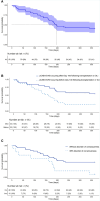CNS manifestations in acute and chronic graft-versus-host disease
- PMID: 39442000
- PMCID: PMC11967822
- DOI: 10.1093/brain/awae340
CNS manifestations in acute and chronic graft-versus-host disease
Abstract
Despite the growing evidence supporting the existence of CNS involvement in acute and chronic graft-versus-host disease (CNS-GvHD), the characteristics and course of the disease are still largely unknown. In this multicentre retrospective study, we analysed the clinical, biological, radiological and histopathological characteristics, as well as the clinical course of 66 patients diagnosed with possible CNS-GvHD (pCNS-GvHD), selected by predetermined diagnostic criteria. Results were then contrasted depending on whether pCNS-GvHD onset occurred before or after Day 100 following allogeneic haematopoietic stem cell transplantation (allo-HSCT). The median time between allo-HSCT and pCNS-GvHD onset was 149 days (interquartile range25-75 48-321), and pCNS-GvHD onset occurred before Day 100 following transplantation in 44% of patients. The most frequent findings at presentation were cognitive impairment (41%), paresis (21%), altered consciousness (20%), sensory impairment (18%) and headache (15%). Clinical presentation did not significantly differ between patients with pCNS-GvHD occurring before or after Day 100 following transplantation. Brain MRI found abnormalities compatible with the clinical picture in 57% of patients, while CT detected abnormalities in only 7%. Seven patients had documented spinal cord MRI abnormalities, all of them with pCNS-GvHD occurring after Day 100 following transplantation. In the CSF, the white blood cell count was increased in 56% of the population (median 18 cells/μl). Histopathological analyses were performed on 12 specimens and were suggestive of pCNS-GvHD in 10. All compatible specimens showed parenchymal and perivascular infiltration by CD3+ and CD163+ cells. Immunosuppressive therapy was prescribed in 97% of patients, achieving complete clinical response in 27%, partial improvement in 47% and stable disease in 6%. Response to immunosuppressive therapy did not differ significantly between patients with pCNS-GvHD occurring before or after Day 100 following transplantation. Clinical relapse was observed in 31% of patients who initially responded to treatment. One-year overall survival following pCNS-GvHD onset was 41%. Onset before Day 100 following haematopoietic stem cell transplantation [hazard ratio with 95% confidence interval: 2.1 (1.0-4.5); P = 0.041] and altered consciousness at initial presentation [3.0 (1.3-6.7); P = 0.0077] were associated with a reduced 1-year overall survival probability. Among surviving patients, 61% had neurological sequelae. This study supports that immune-mediated CNS manifestations may occur following allo-HSCT. These can be associated with both acute and chronic GvHD and carry a grim prognosis. The clinical presentation as well as the radiological and biological findings appear variable.
Keywords: GvHD; brain lesions; encephalitis; immune-mediated; neurological complications; spinal cord lesions.
© The Author(s) 2024. Published by Oxford University Press on behalf of the Guarantors of Brain.
Conflict of interest statement
D.M. received grants from Novartis and CSL Behring, and honoraria for presentations from Novartis, Incyte, Jazz Pharmaceutical, Mallinckrodt, and Sanofi. A.D. received honoraria for presentations from BMS Celgene and support for attending meetings from Incyte, Novartis, and Sanofi. The other authors report no competing interests.
Figures



References
-
- Martinez-Cibrian N, Zeiser R, Perez-Simon JA. Graft-versus-host disease prophylaxis: Pathophysiology-based review on current approaches and future directions. Blood Rev. 2021;48:100792. - PubMed
Publication types
MeSH terms
LinkOut - more resources
Full Text Sources
Research Materials

